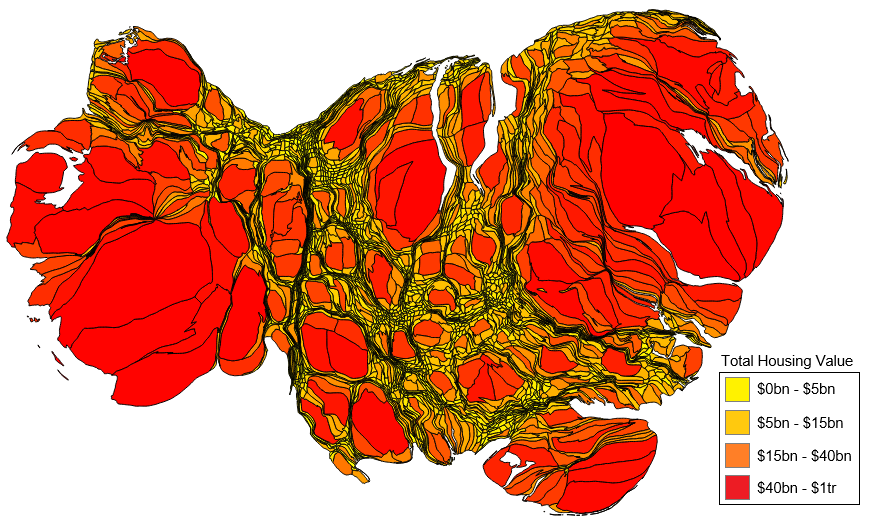The following is a CityLab.com article written by Kriston Capps and posted July 7, 2015, with the title above:
Cartograms are fun tools for swapping out land area for some other variable. For certain figures, especially data that swing wildly at one of the end of the spectrum or another, cartograms are ideal. They’re great at showing systems that are out of balance—and nothing’s more out of whack than New York housing values.
Max Galka, founder of Metrocosm, has posted a series of cartograms over the past few weeks to illustrate just how messed up the city is. As Galka notes, New York City’s 305 square miles make up 8/1000ths of 1 percent of the land area of the United States. Yet New York City accounts for 5 percent of the nation’s housing value—more than every single state but four (one of which is, of course, New York State).
Just a handful of counties account for the vast majority of property values in the U.S. Metrocosm’s June cartograms include one that compares the property value of NYC neighborhoods with various U.S. states. The total value of all the residential property in Kentucky ($300 billion) falls just short of the value of all the housing property in Queens ($317 billion). The housing value of the Upper East Side all by itself is greater than that of six states.
Where it gets really interesting is at the county level. This cartogram [right], which compares property values between counties across the continental United States, looks like bad news from a gastroenterologist. What this in fact shows is that just a handful of counties account for the vast majority of property values in the U.S. The distortion is so severe that it doesn’t look like a map of the U.S. at all.
To make this function even clearer, Galka created an animated GIF, which toggles between the map of land area that we know and love and the map of residential property values that looks like irritable bowel syndrome. The value of housing for most counties in the U.S. is marginal compared to elite counties on the East and West Coasts, Texas, Florida, plus some scattered counties coextensive with major cities or metro areas. The severity of the gap between counties where housing costs so little and those where it costs everything has implications for the whole country.
Maybe that’s no surprise, exactly. But the severity of the gap between counties where housing costs so little and those where housing costs everything is worrying. This gap has implications for the whole country. The stubborn unwillingness of incumbent homeowners in highly productive places [to share wealth]—namely San Francisco and New York City, which are barely visible on the land-area map, but dominate the housing value map—is a huge drain on the nation’s economy.
Folks who can’t afford to live in those places don’t get to take advantage of those labor markets. The demand to live in these places is soaring, but the desire among incumbents to accommodate newcomers is low. Hence NIMBYism, high housing costs, severe inequality—the whole shebang.



